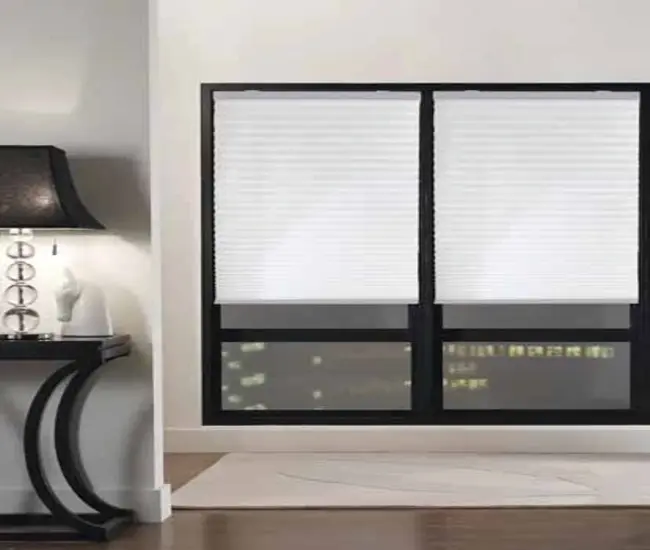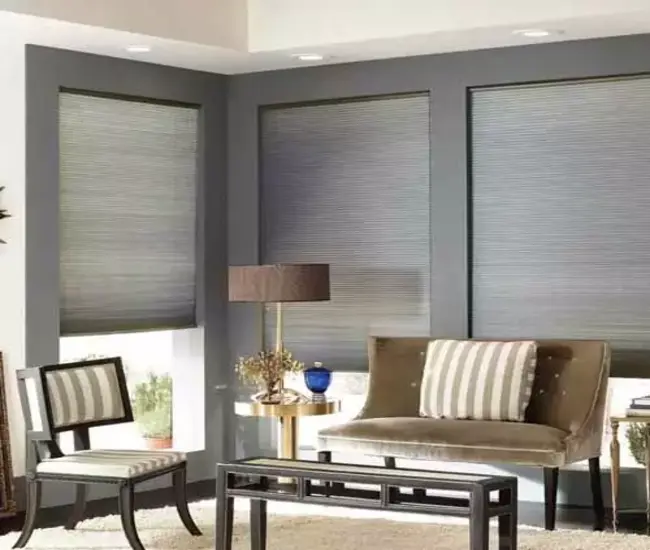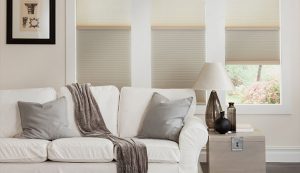Want to know about key structural and functional differences between honeycomb blinds and pleated shades before buying one for your home or office? Here is a comprehensive comparison of the two types of window treatments with pros and cons to choose the better for your needs.
Honeycomb blinds and pleated shades are close relatives, but they do have some conspicuous differences in how they look and function. At first glance, honeycomb and pleated blinds look pretty similar, as they both are constructed from pleated fabrics. Some are woven and others are not woven.
One structural difference between the two is that pleated shades are made from one layer of pleated fabric, while honeycomb blinds tend to use two or more layers of fabric at all times. Two or more layers of fabric form a central air pocket in the shape of a honeycomb.
This structural difference in itself makes a difference to the level of insulation they provide.
Pleated shades provide sufficient light control but less insulation. On the other hand, honeycomb blinds provide incredible insulation and energy efficiency. Honeycomb shades are the most thermally efficient window furnishings around. They resist window heat loss in the winter and reduce window heat in the summer.
However, pleated shades can be lined with a light filtering or room darkening backing for more light control, glare reduction, and temperature regulation.
Honeycomb blinds are available with single cell, double cell, and triple cell designs. Double and triple cell designs offer better insulation than single-cell fabrics.
This guide will help you to narrow down your decision by comparing and contrasting two of the most popular and modern window treatment choices: honeycomb blinds and pleated shades.
Scroll on to learn more so you can design a gorgeous interior, while getting great energy savings.
Similarities between Honeycomb Blinds and Pleated Shades

- Material: Both honeycomb and pleated shades are made from pleated fabrics.
- Design: They have an energy efficient design and are preferred as an energy-saving window treatment option.
- Control Option: Both are typically sold as top down-bottom- up shades, which means they can be raised, lowered, or left somewhere in between.
- Customization: Each type comes in number of color and fabric options, from translucent to room darkening.
- Child-Safety: Both are available with a cordless option for child and pet safety.
Difference Between Honeycomb Blind and Pleated Shades
The main difference between honeycomb and pleated window coverings is that pleated shades are just one large layer of material, rather than two or more layers of material like honeycomb blinds.
What are the Pros of Honeycomb Blinds?

Honeycomb blinds get their name due to the hexagonal, honeycomb-like cells that they are made up of. Honeycomb blinds either come in single-cell or double-cell styles both with the popular top-down-bottom-up cellular shades option. They are made out of one continuous piece of fabric for ease of use.
Honeycomb blinds come with a wide variety of advantages:
Energy Efficient Design
Thanks to their energy efficient design with insulation properties, they can help you to cut down on cooling costs during the summer months and heating costs during the winter months.
Open View
Thanks to the fact that they almost completely disappear when they are fully raised, you can always be sure to enjoy the view from your window when you want to.
Privacy

You can get honeycomb blinds in blackout styles if you are looking for a bit more privacy. Blackout blinds block about 99% of natural light when they are lowered. Faux-Wood-Blinds-to-Enhance-Privacy-and-Security.
Child Safety
Honeycomb blinds come with cordless and motorization options, making them great for households with kids or pets.
Stylish Look
In terms of overall style, they are sleeker and more modern. With that said, they can fit well with just about any window size and decor.
Different Light Control Opacities

Honeycomb blinds offer different light control opacities or openness percentages, ranging from light filtering to room darkening to complete blackout.
What are the cons of honeycomb shades?
- Less light control options than window blinds.
- May be a bit harder to keep clean than other fabric shades.
- Their cellular or honeycomb design easily collects dust and dirt.
What are the Pros of Pleated Shades?
Pleated shades do not come with slats either. There are many benefits of pleated shades that are worth knowing.
Aesthetically Pleasing
They have a sleek and modern look much like honeycomb blinds, which makes them visually appealing.
Cost-Effective

They are a bit less expensive when compared to the average price of honeycomb blinds, making them better for those on a budget.
Let In Natural Light
Pleated shades let in more light than honeycomb blinds. Just like honeycomb blinds, they almost completely disappear when they are raised up.
Safe For Kids and Pets

Just like honeycomb blinds, pleated shades come with cordless options for added safety.
What are Cons of Pleated Shades?
- Pleated shades have holes where the cords run through.
- They are not as energy efficient as blinds with cellular, honeycomb construction.
FAQs
Which is better: pleated or honeycomb shades?
Pleated shades are a more affordable and more stylish option than honeycomb blinds, but they do not have the same ability to save on energy costs that honeycomb blinds offer you due to their incredible insulating abilities.
In terms of energy efficiency, honeycomb shades are a better option, as they can save up to 20% on energy costs! According to the US Department of Energy, honeycomb blinds provide higher heating and cooling energy savings than conventional romans, rollers, 1”vinyl mini blinds, and 2” faux wood blinds.
If you have gas furnaces and heat pumps in your living space, honeycomb window coverings will save up to 3.0 kbut/ft2/year.
Highly efficient insulating cellular blinds are available on the market with credible energy performance ratings for hotter and colder climate zones.
What is the difference between cellular shades and honeycomb shades?
Cellular shades are the same as honeycomb shades. Put simply, ‘cellular’ is another name for honeycomb shades or blinds. Both types inherited their name from the design pattern of honeycomb-like cells or pockets they are made of.
Is it better to have blinds or shades?
If you are looking for durability, blinds are a better choice as they are made of rigid materials and can better withstand wear and tear compared to shades. If you need insulation, cellular shades will be a better option, as they improve the energy efficiency of your home by keeping heat and cold out. When it comes to customization, both types are available in a variety of styles, colors, and sizes.
Where to Buy Honeycomb or Pleated Shades?

Affordable Blinds is one of the best companies, providing high-quality window treatments at great low prices. High-quality window treatments are notoriously inaccessible. Our aim is to squash that idea. Here you will find a curated collection of honeycomb blinds and pleated shades.
Need More Help?
Need expert advice on the choice of honeycomb blinds or pleated shades for your unique needs? Contact our professionals using 24/7 live chat or give us a ring at (800) 863-6109.
